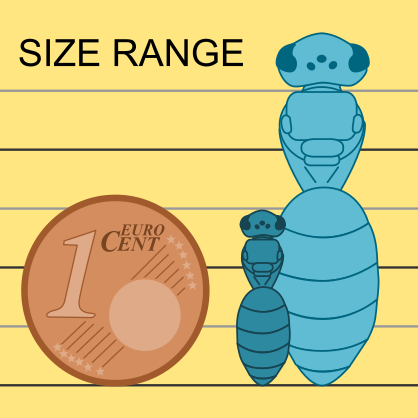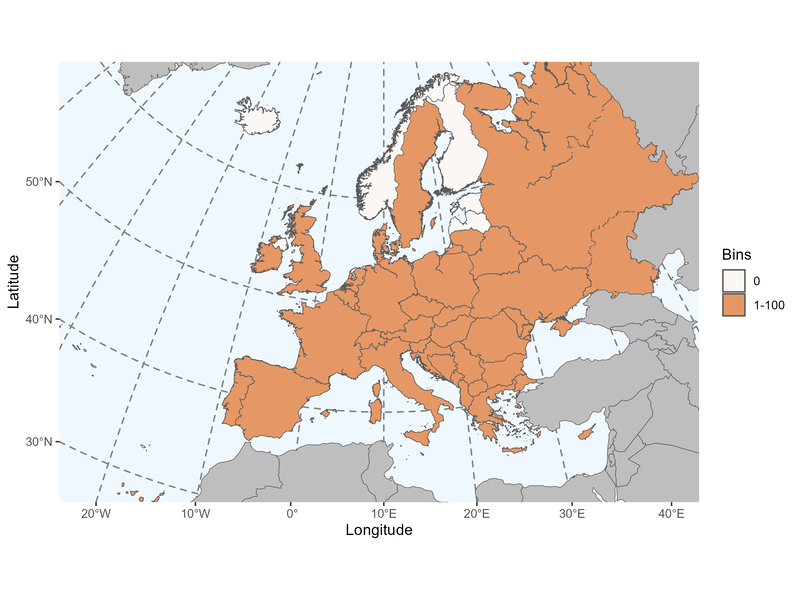Author: Latreille, 1802
|
Type species: Apis violacea Linnaeus, 1758, by designation of Westwood, 1840: 86.
Subgenera: Afroxylocopa Hurd and Moure, 1963; Copoxylocopa Maa, 1954; Koptorthosoma Gribodo, 1894; Proxylocopa Hedicke, 1938; Rhysoxylocopa Hurd and Moure, 1963; Xylocopa s. str. Latreille, 1802; Xylocopoides Michener, 1954. Synonyms: Koptorthosoma Dalla Torre, 1896; Cyaneoderes Ashmead, 1899; Coptorthosoma Pérez, 1901; Euryapis Sandhouse, 1943; Xilocopa Latreille, 1802. |
Clade: Anthophila
Family: Apidae Subfamily: Xylocopinae Tribe: Xylocopini |
|
Distinctive traits
|
Pictures of distinctive traits.
|
Morphologically close genera and how to distinguish them:
Xylocopa species could be confused with other large black bees if looked upon only superficially.
Andrena species have submarginal cell 3 smaller than submarginal cell 2, and two subantennal sutures.
Xylocopa species could be confused with other large black bees if looked upon only superficially.
- Xylocopa - Andrena
Andrena species have submarginal cell 3 smaller than submarginal cell 2, and two subantennal sutures.
General comments on Xylocopa species identification
Some of the european Xylocopa species can readily be identified using the yellow hairs patterns. The dark species require more subtle traits such as ones related to the pygidial plate.
Some of the european Xylocopa species can readily be identified using the yellow hairs patterns. The dark species require more subtle traits such as ones related to the pygidial plate.
Sorry, but the species identification tool is not yet available for Xylocopa.
Please check the reference(s) at the bottom of the page for traditional keys.
Please check the reference(s) at the bottom of the page for traditional keys.
List of the 9 Xylocopa species found in Europe (Ghisbain et al. 2023)
Xylocopa (Copoxyla) iris (Christ, 1791)
Xylocopa (Koptortosoma) pubescens Spinola, 1838
Xylocopa (Mesotrichia) nigrita (Fabricius, 1775)
Xylocopa (Proxylocopa) olivieri Lepeletier, 1841
Xylocopa (Rhysoxylocopa) amedaei Lepeletier, 1841
Xylocopa (Rhysoxylocopa) cantabrita Lepeletier, 1841
Xylocopa (Xylocopa) valga Gerstaecker 1872
Xylocopa (Xylocopa) violacea Linnaeus, 1758
Xylocopa (Xylocopoides) virginica (Linnaeus, 1771)
Xylocopa (Copoxyla) iris (Christ, 1791)
Xylocopa (Koptortosoma) pubescens Spinola, 1838
Xylocopa (Mesotrichia) nigrita (Fabricius, 1775)
Xylocopa (Proxylocopa) olivieri Lepeletier, 1841
Xylocopa (Rhysoxylocopa) amedaei Lepeletier, 1841
Xylocopa (Rhysoxylocopa) cantabrita Lepeletier, 1841
Xylocopa (Xylocopa) valga Gerstaecker 1872
Xylocopa (Xylocopa) violacea Linnaeus, 1758
Xylocopa (Xylocopoides) virginica (Linnaeus, 1771)
References with identification keys for some of the species:
- Amiet, F., Herrmann, M., Müller, A., & Neumeyer, R. (2007). Apidae 5: Ammobates, Ammobatoides, Anthophora, Biastes, Ceratina, Dasypoda, Epeoloides, Epeolus, Eucera, Macropis, Melecta, Melitta, Nomada, Pasites, Tetralonia, Thyreus, Xylocopa (Vol. 5). Centre suisse de cartographie de la faune.
- Terzo, M., Iserbyt, S., & Rasmont, P. (2007). Révision des Xylocopinae (Hymenoptera: Apidae) de France et de Belgique. In Annales de la Société Entomologique de France 43(4) : 445-491.
- Falk S.J. (2015) Field Guide to the Bees of Great Britain and Ireland. Bloomsbury wildlife guides. 432 p.
Online resources:
Atlas hymenoptera (Europe & France)
BWARS (UK)
Discover Life (World)
WestPalBees (West Palearctic)
Atlas hymenoptera (Europe & France)
BWARS (UK)
Discover Life (World)
WestPalBees (West Palearctic)
Page contributors:
You noticed a mistake? You have a suggestion to improve this page?
Don't keep it to yourself, contact us and become a contributor to IDmyBee!
- Adrien Perrard (Dec. 2023)
- Adrien Perrard (Dec. 2019)
You noticed a mistake? You have a suggestion to improve this page?
Don't keep it to yourself, contact us and become a contributor to IDmyBee!
References used to write this page:
- Ghisbain, G., Rosa, P., Bogusch, P., Flaminio, S., Le Divelec, R., Dorchin, A., Kasparek, M., Kuhlmann, M., Litman, J., Mignot, M., Müller, A., Praz, C., Radchenko, V.G., Rasmont, P., Risch, S., Roberts, S.P.M., Smit, J., Wood, T.J., Michez, D. & Reverte, S. (2023). The new annotated checklist of the wild bees of Europe (Hymenoptera: Anthophila). Zootaxa, 5327(1), 1-147.
- Michener, C.D. 2007. The Bees of the World, 2nd Edition. The John Hopkins University Press, Baltimore.
- Michez D., Rasmont P., Terzo, M., Vereecken, N. 2019. Abeilles d'Europes. Hymenoptères d'Europes, Volume 1. N.A.P. Editions.
- Nieto, A., Roberts, S. P., Kemp, J., Rasmont, P., Kuhlmann, M., García Criado, M., ... & Michez, D. 2014. European red list of bees. Luxembourg: Publication Office of the European Union, 98.
- Rasmont, P., Devalez, Jelle, Pauly, A., Michez, D. & Radchenko, V.G. 2017. Addition to the checklist of IUCN European wild bees (Hymenoptera: Apoidea). Annales de la Société entomologique de France 53: 17-32.



